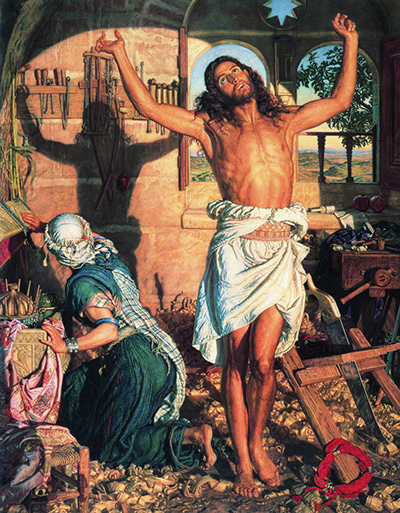Holman Hunt worked on The Shadow of Death between 1870-73. He spent time in Palestine painting and making observations to ensure that he captured every archeological detail of clothing and tools accurately.
He had painted religious subject matter before, namely The Scapegoat and Light of the World during earlier trips to the Holy Land.
The Shadow of Death is a painting that requires the viewer to observe and consider the details closely. The scene depicts a young Jesus during his working day as a carpenter.
The room is filled with his tools and wood shavings are scattered across the floor. The young, muscular Jesus stretches after a hard day at work and as he does so his shadow falls across the rack of tools.
The shadow is the image of Christ on the crucifix. His mother, Mary, on the floor kneeling beside him, has turned to look at the shadow.
There are many fascinating elements contained within the image. Holman Hunt has used a star in the stonework to represent the star of Bethlehem above Jesus's head and the arch of the window provides a halo effect.
Experts have noted that many of the tools were also used to torture Jesus; the shadow of the saw takes on the image of the spear that pierces his side, the plumb-line's shadow is placed near his heart.
Both Jesus's and Mary's images are not painted in the conventional way. Jesus was deliberately painted to indicate a young, fit man extolling the virtues of health and strength alongside Christian values (Muscular Christianity).
Mary was controversially painted with her back towards the viewer and unusually wears jewellery and displays muscles from hard work too. There are other symbols within the painting such as the pomegranates on the window ledge, the gifts that were given to them by the Magi, the red headwear discarded on the floor.
It seems that Holman Hunt paid the greatest attention to detail regardless of what critics might have thought of his scene. It is said that he spent days repainting the face of Jesus in order to get the precise expression he desired.
Hunt went on to create an engraving of the image and a smaller version of the painting in 1873. This sold for 1.8 million pounds and is now in Leeds Gallery. The original painting, an oil on canvas, is held by Manchester City Art Gallery.




